Physical Address
304 North Cardinal St.
Dorchester Center, MA 02124
Physical Address
304 North Cardinal St.
Dorchester Center, MA 02124

Mesmerizing island sanctuaries vie for your vacation dreams, but only one matches your ideal escape—discover which paradise awaits.
You’re planning your next tropical getaway, and two island paradises have made your shortlist. Both Bali and Fiji offer stunning beaches, warm hospitality, and unforgettable experiences—but they couldn’t be more different in character. Will you choose Bali’s vibrant cultural landscape and affordable adventures, or Fiji’s pristine seclusion and luxury escapes? The answer lies in what you value most in a vacation and how you prefer to spend your hard-earned travel budget.
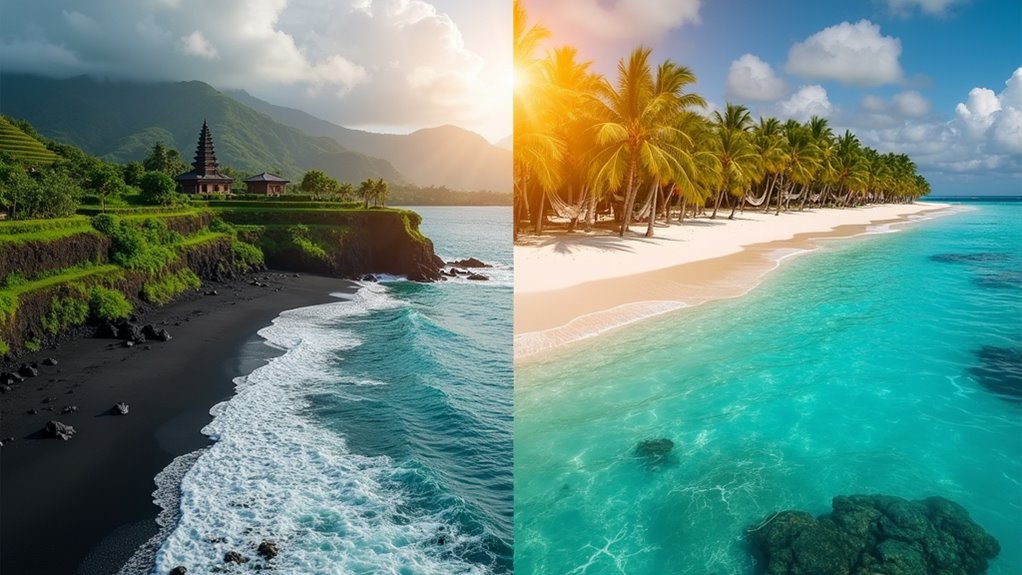
When it comes to beach destinations, Fiji and Bali offer distinctly different coastal experiences that cater to various traveler preferences.
Fiji’s beaches boast pristine white sands and crystal-clear turquoise waters, providing ideal conditions for snorkeling and diving. You’ll find these beaches generally cleaner, less crowded, and perfectly suited for the classic tropical paradise experience.
Pristine white sands meet turquoise waters in Fiji—nature’s uncrowded masterpiece for the ultimate tropical escape.
In contrast, Bali presents more diverse coastlines, including unique black sand beaches in the north near Lovina. While famous spots like Kuta draw crowds, they often struggle with waste management issues. Marine debris issues are common in Bali, with local communities organizing frequent beach cleanups to maintain coastal beauty. After a day at the beach, visitors can enjoy authentic Balinese cuisine flavors that feature rich spices and unique preparations not found in Fiji.
Bali’s beaches, though scenic and atmospheric, typically don’t match Fiji’s opulent tranquility and cleanliness.
Your choice ultimately depends on priorities: Fiji delivers unspoiled beach perfection, while Bali offers charming but busier coastal areas alongside its rich cultural attractions.
While both destinations offer unique cultural experiences, Bali is distinguished by its extraordinarily vibrant spiritual heritage that permeates every aspect of daily life. The island’s deep-rooted Hinduism manifests through daily rituals, sacred ceremonies, and ancient temples adorned with intricate stone carvings. As a premier entertainment destination, Bali also hosts the world’s biggest beach club that attracts international travelers seeking both cultural and leisure experiences. With various visa options available, travelers can extend their stay to fully enjoy the island’s rich cultural offerings.
You’ll find Bali’s culture opportunities far exceed what’s typically available in other island destinations, making it ideal for travelers seeking both relaxation and cultural enrichment.
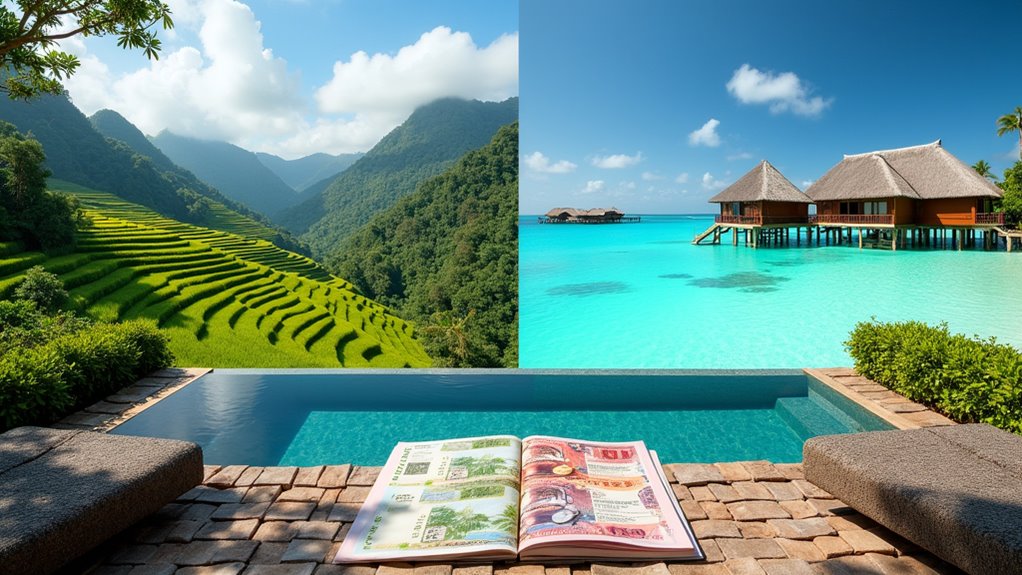
The stark financial contrast between Bali and Fiji creates distinctly different vacation experiences for travelers at every budget level.
In Bali, your dollar stretches markedly further—accommodation ranges from $5 hostels to $500+ villas, while Fiji’s options start around $50 for basic bures and quickly escalate to $800 nightly for luxury resorts.
This price gap extends across all vacation elements: Bali’s street food costs under $3 compared to Fiji’s $5-10 meals, transportation runs 60-70% cheaper, and activities like diving or spa treatments cost half what you’ll pay in Fiji. The fluctuating exchange rates can sometimes further amplify or reduce these price differences, especially for international travelers.
Even Bali’s mid-range options often match Fiji’s entry-level luxury experiences at substantially lower prices.
For budget travelers, Bali offers tremendous value, while Fiji positions itself firmly as a premium destination where all-inclusive packages offset some sticker shock. For those torn between Bali and closer alternatives, neighboring Lombok provides a less commercialized experience with similar budget-friendly advantages.
Beyond vacation budgets, today’s travelers often seek destinations where they can blend work and leisure. If you’re considering a workation, Bali clearly outshines Fiji as a digital nomad haven. With its B211a Visa designed specifically for remote workers, Bali offers the legal framework and infrastructure you need for productive long-term stays.
For the modern hybrid traveler, Bali provides the ultimate workation ecosystem where productivity meets paradise.
While Fiji offers stunning beaches, Bali delivers the complete package for those needing to balance work responsibilities with tropical living. Canggu in Bali has evolved from a surf town into a tropical hotspot with community-focused coworking spaces like Outpost Canggu providing reliable internet for digital nomads. For those seeking to explore beyond Bali, nearby Lombok island offers similar remote work possibilities with less crowded beaches and a more laid-back atmosphere.
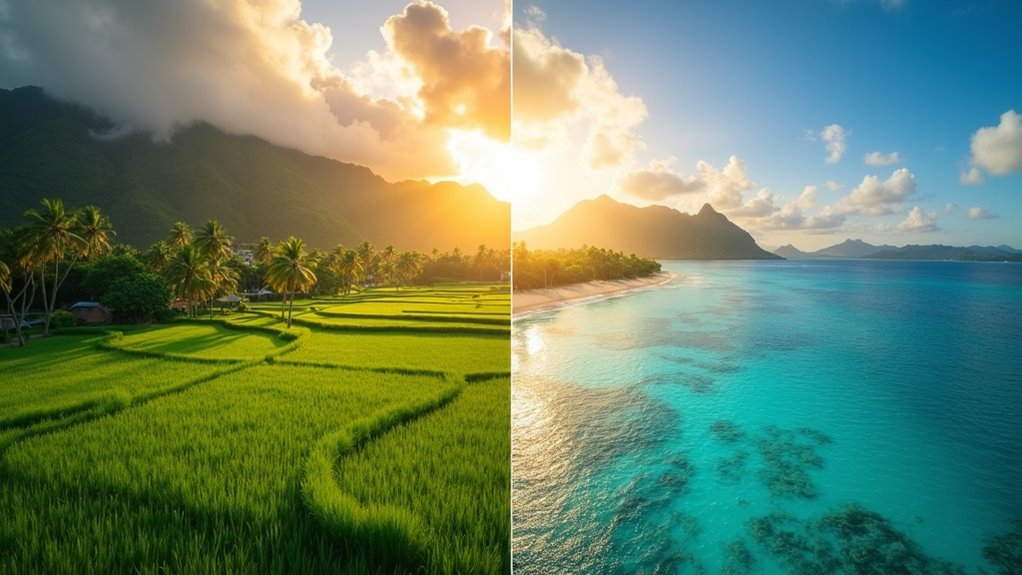
Choosing the right time to visit can make or break your tropical getaway, as both Bali and Fiji experience distinct seasonal patterns that affect everything from prices to weather conditions.
Bali’s clear winner for ideal weather is May through October, during its dry season. You’ll enjoy clear skies and less humidity, perfect for exploring temples and beaches.
Meanwhile, Fiji offers more flexibility with its stable climate year-round, though the southern hemisphere winter (June-September) remains most popular.
Both destinations see tourist surges during school holidays and northern hemisphere summers, driving up prices. If you’re budget-conscious, consider shoulder seasons—April/May or September/October for Bali, and April or October for Fiji—when you’ll find better deals without sacrificing too much sunshine.
For those interested in Bali’s eastern coast, Sanur beach offers a more relaxed alternative to busier tourist areas, with calmer waters and stunning sunrise views.
Temperature data shows Fiji maintains a warmer climate throughout the year compared to Bali, with average monthly temperatures about 1.78°C higher.
Diving beneath the surface reveals perhaps the starkest contrast between these island paradises, as Bali and Fiji each offer distinctly different underwater experiences for snorkelers and divers. Bali excels with accessible, budget-friendly dive sites perfect for macro photography enthusiasts seeking frogfish, nudibranchs, and seahorses. In Bali, visitors can explore top snorkeling spots that showcase the island’s incredible underwater beauty without advanced diving certifications.
Meanwhile, Fiji’s crystal-clear waters showcase pristine ecosystems with larger marine species like sharks and rays. Fiji’s Rainbow Reef is especially renowned as the soft coral capital of the world, spanning 7,500 hectares with vibrant reef fish and rainbow-hued corals.
Fiji’s underwater paradise reveals itself as a pristine realm where majestic sharks and graceful rays glide through transparent waters.
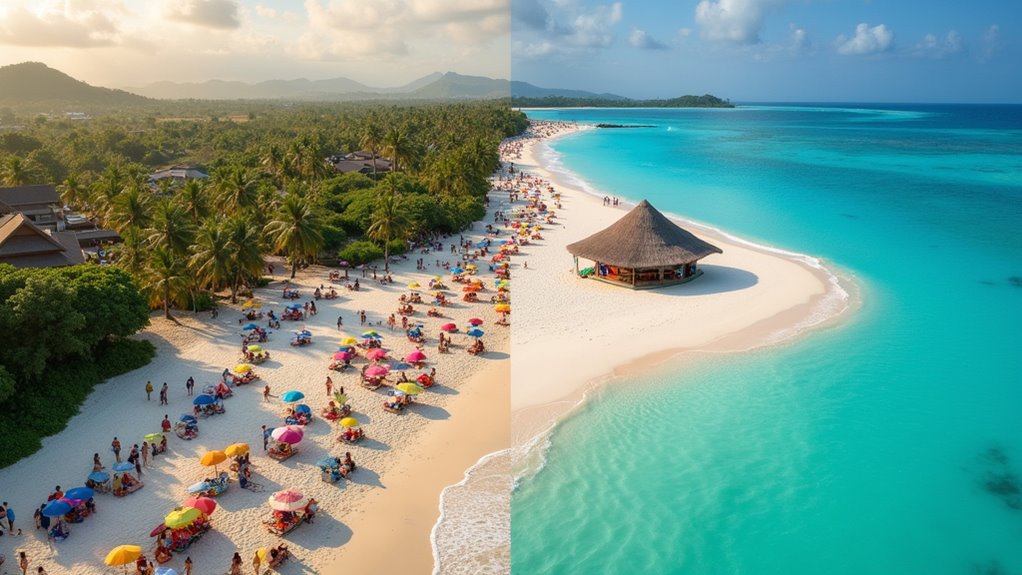
When it comes to managing crowds during your island getaway, Bali and Fiji present dramatically different experiences. Bali hosts over 6.3 million visitors annually—averaging 527,780 monthly—with steady year-round tourism and peaks exceeding 550,000 in December. The December 2024 statistics show a +16.54% increase in visitors compared to November, highlighting Bali’s growing popularity.
Fiji welcomes significantly fewer travelers (about 929,000 yearly) and offers natural crowd relief during its November-April cyclone season when visitor numbers drop by 40%. If you’re seeking seclusion, Fiji’s 15+ private island resorts and the exclusive Yasawa Group provide genuine isolation.
Bali’s crowds concentrate in the south, but you’ll find respite in northern areas like Amed and Lovina, where density drops 60%. For couples seeking romance, Bali offers numerous romantic getaway options in secluded locations. For ultimate privacy, consider Fiji’s boutique island resorts or Bali’s emerging villa developments in Pererenan and Medewi, where you’ll escape the tourist throngs.
Nightlife experiences differ dramatically between Bali and Fiji, reflecting their distinct cultural approaches to after-dark entertainment. Bali buzzes with energy at beach clubs in Seminyak and Canggu, where DJs spin until dawn, while Fiji embraces resort-based cultural shows ending much earlier. Your evening preferences will largely determine which destination suits you better. Bali’s vibrant scene includes popular venues like Potato Head Beach Club that attract international travelers seeking lively entertainment options. For adventurous visitors, Jakarta offers thrilling activities just a short flight away from Bali’s party scene.
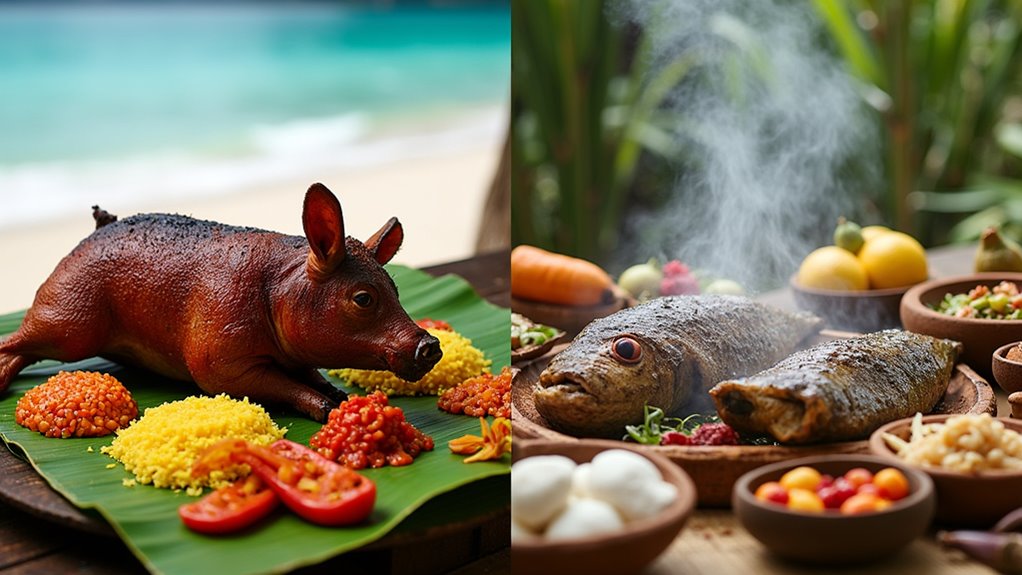
The culinary landscapes of Bali and Fiji offer as much contrast as their evening entertainment scenes, providing travelers with distinctly different flavor experiences.
In Bali, you’ll find affordable street food featuring nasi goreng, satay, and rendang alongside high-end Michelin-starred restaurants. Local markets like Ubud offer authentic culinary exploration, while cooking classes let you master traditional dishes yourself. Balinese cuisine is predominantly rice-based dishes, accompanied by flavorful sambals, curried meats, and sautéed vegetables. For a truly unique dining experience, consider visiting Nusa Lembongan Island where fresh seafood is served with spectacular ocean views.
Fiji’s dining scene centers around resort experiences, with higher price points but exceptional quality. Fresh seafood dominates the menu, particularly in signature dishes like kokoda (marinated fish salad) and palusami (taro leaves with coconut cream). Family-friendly dining options are abundant at resorts.
Both destinations emphasize fresh ingredients, but Bali wins on affordability and variety, while Fiji excels in luxury dining experiences with stunning ocean views.
Both Bali and Fiji offer natural paradises for exploration, though they present distinctly different island-hopping experiences for travelers seeking to connect with nature.
Fiji shines with its 300+ islands, particularly the stunning Mamanuca and Yasawa chains, where affordable boat transportation makes island-hopping accessible. You’ll find secluded beaches and untouched beauty perfect for multiday adventures. Visiting during the mild, dry season from May to November provides optimal weather conditions for outdoor explorations.
When exploring Bali, travelers should remain vigilant about dangerous animals that inhabit the island’s diverse ecosystems.
Whether Bali’s cultural tapestry or Fiji’s pristine shores call your name, you can’t go wrong with either paradise. While Bali gives you more bang for your buck with vibrant markets and temple hopping, Fiji offers that exclusive island escape you’ve dreamed about. Consider your travel style, budget, and what truly recharges your batteries before booking your flight to these tropical gems.